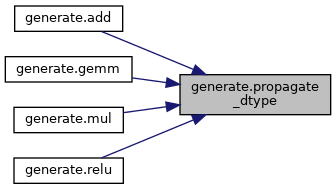Functions | |
| def | propagate_dtype (outputs, dtype) |
| def | add (self, a, b) |
| def | mul (self, a, b) |
| def | gemm (self, a, b, trans_a=False, trans_b=False) |
| def | relu (self, a) |
| def | min (self, *args) |
| def | max (self, *args) |
| def | identity (self, inp) |
| def | shape (self, a) |
| def | reduce_prod (self, a, axes, keepdims=True) |
| def | reshape (self, data, shape) |
| def | gather (self, data, indices) |
| def | concat (self, inputs, axis=0) |
Variables | |
| tuple | shape = (1, 3, 224, 224) |
| x0 = gs.Variable(name="x0", dtype=np.float32, shape=shape) | |
| x1 = gs.Variable(name="x1", dtype=np.float32, shape=shape) | |
| a = gs.Constant("a", values=np.ones(shape=shape, dtype=np.float32)) | |
| b = gs.Constant("b", values=np.ones(shape=shape, dtype=np.float32)) | |
| mul_out = gs.Variable(name="mul_out") | |
| add_out = gs.Variable(name="add_out") | |
| Y = gs.Variable(name="Y", dtype=np.float32, shape=shape) | |
| list | nodes |
| graph = gs.Graph(nodes=nodes, inputs=[x0, x1], outputs=[Y]) | |
| The functions registered above greatly simplify the process of building the graph itself. More... | |
| input = gs.Variable("input", shape=shape, dtype=np.float32) | |
| c = gs.Variable("c") | |
| d = gs.Constant("d", values=np.ones(shape=shape, dtype=np.float32)) | |
| e = gs.Variable("e") | |
| output = gs.Variable("output", shape=shape, dtype=np.float32) | |
| x = gs.Variable(name="x", dtype=np.float32, shape=(1, 3, 224, 224)) | |
| i0 = gs.Variable(name="i0") | |
| i1 = gs.Variable(name="i1") | |
| y = gs.Variable(name="y", dtype=np.float32) | |
| X = gs.Variable(name="X", shape=(64, 64), dtype=np.float32) | |
| inputs | |
| A = np.ones(shape=(64, 64), dtype=np.float32) | |
| def | axt = graph.gemm(A, X, trans_b=True) |
| float | B = np.ones((64, 64), dtype=np.float32) * 0.5 |
| def | dense = graph.relu(*graph.add(*axt, B)) |
| C = gs.Constant(name="C", values=np.ones(shape=(64, 64), dtype=np.float32)) | |
| D = np.ones(shape=(64, 64), dtype=np.float32) | |
| outputs | |
| dtype | |
| MIN_VAL = np.array(0, np.float32) | |
| MAX_VAL = np.array(6, np.float32) | |
| def | inp = graph.identity(graph.inputs[0]) |
| def | max_out = graph.max(graph.min(inp, MAX_VAL), MIN_VAL) |
| float32 | |
| name | |
| def | input_shape = graph.shape(graph.inputs[0]) |
| def | volume = graph.reduce_prod(input_shape, axes=[0]) |
| def | flattened = graph.reshape(graph.inputs[0], volume) |
| def | NC = graph.gather(input_shape, indices=[0, 1]) |
| def | HW = graph.gather(input_shape, indices=[2, 3]) |
| def | new_shape = graph.concat([NC, graph.reduce_prod(HW, axes=[0])]) |
| def | partially_flattened = graph.reshape(graph.inputs[0], new_shape) |
| def generate.propagate_dtype | ( | outputs, | |
| dtype | |||
| ) |

| def generate.add | ( | self, | |
| a, | |||
| b | |||
| ) |

| def generate.mul | ( | self, | |
| a, | |||
| b | |||
| ) |

| def generate.gemm | ( | self, | |
| a, | |||
| b, | |||
trans_a = False, |
|||
trans_b = False |
|||
| ) |

| def generate.relu | ( | self, | |
| a | |||
| ) |

| def generate.min | ( | self, | |
| * | args | ||
| ) |
| def generate.max | ( | self, | |
| * | args | ||
| ) |
| def generate.identity | ( | self, | |
| inp | |||
| ) |
| def generate.shape | ( | self, | |
| a | |||
| ) |
| def generate.reduce_prod | ( | self, | |
| a, | |||
| axes, | |||
keepdims = True |
|||
| ) |
| def generate.reshape | ( | self, | |
| data, | |||
| shape | |||
| ) |
| def generate.gather | ( | self, | |
| data, | |||
| indices | |||
| ) |
| def generate.concat | ( | self, | |
| inputs, | |||
axis = 0 |
|||
| ) |
| tuple generate.shape = (1, 3, 224, 224) |
| generate.mul_out = gs.Variable(name="mul_out") |
| generate.add_out = gs.Variable(name="add_out") |
| list generate.nodes |
The functions registered above greatly simplify the process of building the graph itself.
| generate.c = gs.Variable("c") |
| generate.e = gs.Variable("e") |
| generate.i0 = gs.Variable(name="i0") |
| generate.i1 = gs.Variable(name="i1") |
| generate.y = gs.Variable(name="y", dtype=np.float32) |
| generate.inputs |
| float generate.B = np.ones((64, 64), dtype=np.float32) * 0.5 |
| generate.outputs |
| generate.dtype |
| generate.MIN_VAL = np.array(0, np.float32) |
| generate.MAX_VAL = np.array(6, np.float32) |
| def generate.inp = graph.identity(graph.inputs[0]) |
| generate.float32 |
| generate.name |
| def generate.input_shape = graph.shape(graph.inputs[0]) |
| def generate.volume = graph.reduce_prod(input_shape, axes=[0]) |
| def generate.flattened = graph.reshape(graph.inputs[0], volume) |
| def generate.NC = graph.gather(input_shape, indices=[0, 1]) |
| def generate.HW = graph.gather(input_shape, indices=[2, 3]) |
| def generate.partially_flattened = graph.reshape(graph.inputs[0], new_shape) |